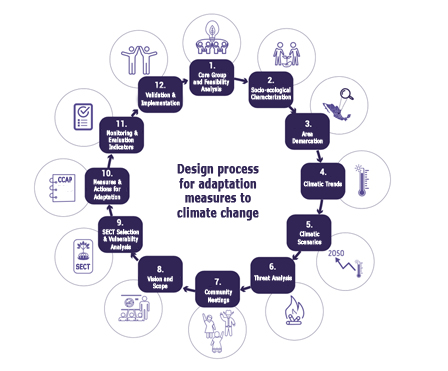Resilience Project leaves a lot of work to do in Northwest Mexico

Designing CCAPs in ANPs involves a series of steps aimed at recovering the connectivity of priority ecosystems and increasing representativeness, all financed by policies for climate change resilience. (SCT stands for socio-ecological conservation targets). Click to enlarge. Image: courtesy Conanp (adapted from original) .
One of the main challenges that we face today, climate change has widely documented negative impacts that we are experiencing and overwhelming consequences that will come from not taking steps to reduce the cause or adapt to the effect.
Among those that we can see in Northwest Mexico are the increases in desertification and temperatures, changes in the frequency and intensity of rainfall patterns, the earlier arrival of hot seasons, and the loss of wildlife, as well as the most recent manifestation, the current Covid-19 pandemic.
Public institutions, private interests and civil society organizations have undertaken various initiatives to counter these problems, but a lot of hard work remains to be done.
Entities focused on conservation have been carrying out Proyecto Resiliencia (the Resilience Project) for more than five years. The program is run by the National Commission for Natural Protected Areas (Conanp), implemented by the United Nations Development Program (UNDP) in Mexico and co-financed by a donation from the Global Environment Fund (GEF).
Using an ecosystems adaptation approach, the activities they have prescribed aim to go as far as possible hand in hand with the participation of all sectors.
In our region, the Resilience Project has a presence in six protected natural areas:
- Constitution 1857 National Park (Baja California)
- El Vizcaíno Biosphere Reserve (Baja California Sur)
- Bahía de los Ángeles Biosphere Reserve (Baja California)
- Islands and Protected Areas of the Gulf of California (Baja California, Baja California Sur, Sonora, Sinaloa)
- Janos Biosphere Reserve (Chihuahua y Sonora)
- Sierra de San Pedro Mártir National Park (Baja California)
Throughout the life of the project, its principle contribution has been the elaboration of Climate Change Adaptation Programs (CCAPs) linked to Management Programs in Protected Natural Areas, with the aim of recovering the connectivity of priority ecosystems and strengthening their governance through community involvement.
However, as it nears the end of its funding, the Resilience Project falls short of its most difficult task: that of carrying out actions to facilitate the financing and implementation of the measures identified in the CCAPs.
It is not only the government and the institutions mentioned above that promote these projects. Civil society is also accountable and plays a very important role — that of informing, intervening, participating in decision-making and in those tasks that allow reducing conditions of vulnerability, as well as increasing people's adaptive capacity.
